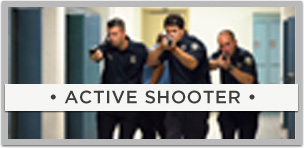LAW ENFORCEMENT TRAINING FOR HIGH RISK SCENARIOS
DOMESTIC VIOLENCE:
How do you approach the home where a domestic violence incident has been reported? How would you screen a teenager for signs of abuse? What priorities do you address when the dispute is ongoing? How do you help the victims break the cycle of violence?
See a trailer of our Active Shooter module or schedule a demo of the Domestic Violence module.
ACT’s Domestic Violence Module addresses these questions and more. It’s night time. You just came on shift and are driving on patrol when the dispatcher calls. A teenage girl has called 911 to report that her parents are in a fight. You arrive on scene and begin to assess the situation. You call for backup and approach the residence. What now?
At first you will focus on critical decision points that arise during a domestic violence incident. You will have the opportunity to select from a menu of possible decisions and to see the practical results of the choices you make. At each point, you will be prompted to think about the factors that go into making a decision. Later, you will be asked how your choices would change as the conditions in the scenario change.
Next, you will return and view each situation and response a second time. This time, you will be prompted to focus on the details of the response. How should the officer approach the front door? How would he check the teenager for injuries? How does the officer position himself when he enters the room where the fighting is taking place? How do officers work together as a team? At various points, you will be afforded the opportunity to view authoritative documents so that you can study particular points in more detail. Again, you will be asked later to critique each detail of the officer’s response and reflect on how changing circumstances would change that response.
The complexity of domestic violence calls requires officers to be extremely well-trained and to be proficient in making good decisions. With Active Continuous Training’s Domestic Violence Module, you will be better prepared to make critical decisions and to maintain your tactical edge while responding to a domestic violence call.
Vehicle Stop
How do you position your patrol car during a vehicle stop? Is the location a good one? How would you issue voice commands? How do you approach the stopped vehicle?
See a trailer of our Active Shooter module or schedule a demo of the Vehicle Stop module.
ACT’s Vehicle Stop Module addresses these questions and more. You are monitoring traffic in your community. A car comes by driving above the speed limit and crossing the yellow center line. You pull out and begin the vehicle stop sequence. At first, you will evaluate the location, the delivery of voice commands over the patrol car’s public announcement system, and the officer’s approach to the stopped vehicle. You will make choices and experience the outcomes of different approaches.
Next, you will return and view each situation and approach a second time. This time, you will be prompted to focus on the details of the response. How do you use the patrol car’s lights and siren during the stop? How should the officer deal with a driver who exits the vehicle? How does the officer maintain situational awareness and scan for signs of trouble?
You will be challenged to think about the factors that go into making a decision. Later, you will be asked how your choices would change as the conditions change. At various points, you will be afforded the opportunity to view authoritative documents so that you can study particular points in more detail. Again, you will be asked later to critique each detail of the officer’s response and reflect on how changing circumstances would change that response.
Stopping a motor vehicle for a traffic violation can be one of the most dangerous enforcement actions an officer can engage in. The motor vehicle stop requires officers to be extremely well-trained and to be proficient in making good decisions. With Active Continuous Training’s Vehicle Stop Module, you will be better prepared to make critical decisions and to maintain your tactical edge while conducting a motor vehicle stop.
ACTIVE SHOOTER
How do you decide when to enter a school building where a shooting has been reported? How does the initial tactical entry team treat innocents and victims who have been badly injured? When would you search a room and when would you keep moving?
See a trailer of our Active Shooter module or schedule a demo of the Active Shooter module.
ACT’s Active Shooter Module addresses these questions and more. You are patrolling your community when the dispatcher alerts you that there has been a shooting incident in the local high school. You are the first to arrive on scene. What do you do?
At first you will focus on critical decision points that arise during the initial response to an active shooter incident. You will have the opportunity to select from a menu of possible decisions and to see the practical results of the choices you make. At each point, you will be prompted to think about the factors that go into making a decision. Later, you will be asked how your choices would change as the conditions in the scenario change.
Next, you will return and view each situation and response a second time. This time, you will be prompted to focus on the details of the response. What questions should the initial tactical entry team ask to gain an advantage? What are the priorities of the initial on scene incident commander? How does the team react as new information is learned? At various points, you will be afforded the opportunity to view authoritative documents so that you can study particular points in more detail. Again, you will be asked later to critique each detail of the officer’s response and reflect on how changing circumstances would change that response.
The complexity of an active shooter situation requires officers to be extremely well-trained and proficient in making good decisions. You will need to make decisions about entering a building where there is gunfire. Once in the building, you will have to continue to make decisions and to react when you learn new information. With Active Continuous Training’s Active Shooter Module, you will be better prepared to make critical decisions such as these and to maintain your tactical edge during the incident.
ACT PHASE III LESSON PLANS AND PRESENTATIONS:
Agency users will be provided lesson plans and a presentation to facilitate collective training on the ACT Modules their agency purchases. Here are examples of the content of ACT lesson plans and presentations.


